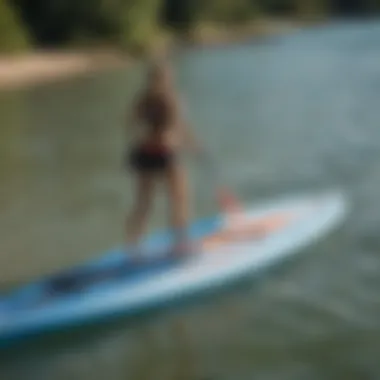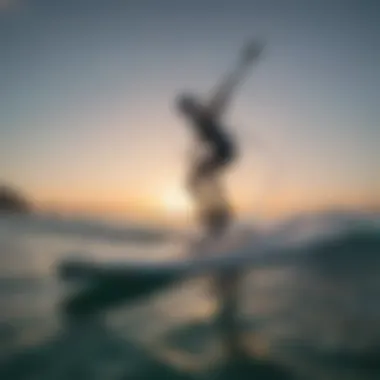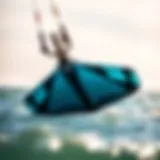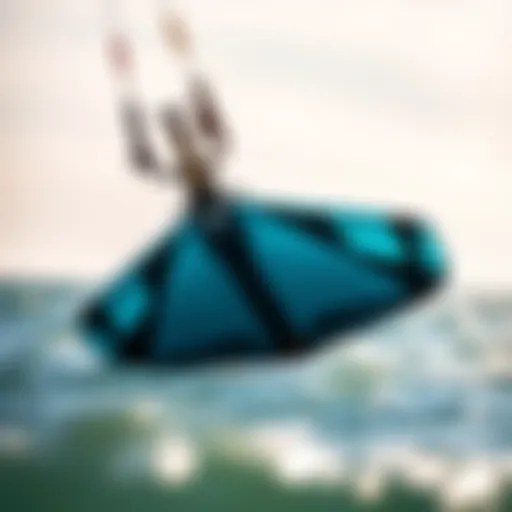Understanding Wing Sup Boards for Kiteboarding Enthusiasts


Intro
Wing sup boards, a recent advent in the kiteboarding arena, are swiftly altering the landscape of water sports. With their attractive blend of design and performance, these boards have captivated both budding enthusiasts and seasoned veterans alike. Whether you’re a beginner eager to grasp the basics or a professional looking to polish your skills, understanding these boards is essential.
As kiteboarding continues to grow in popularity, the introduction of wing sup boards has opened new avenues for creativity and enjoyment on the water. This article aims to demystify these boards, looking closely at their engineering, functional advantages, and how they can enhance your kiteboarding experience.
We will navigate through essential techniques suited for various skill levels, delve into gear reviews to guide your purchasing decisions, and ultimately synthesize our findings to equip you for better rides on any given day.
"Mastering the art of wing sup boarding might take time, but having the right knowledge can skip you ahead of the curve.”
Through this exploration, expect to gain insights not just about the equipment itself, but also practical applications that can elevate your riding capabilities. Let's dive right in!
Foreword to Wing Sup Boards
This section lays the groundwork for understanding the various aspects of wing sup boards. Delving into this topic is not just an exploration of equipment; it’s an invitation to comprehend how these boards enhance the kiteboarding experience. The rise of wing sup boards has carved a niche in an already vibrant sport, making it crucial to grasp their significance.
What are Wing Sup Boards?
Wing sup boards represent a fusion of stand-up paddleboarding and the exhilarating dynamics of wing foiling. Essentially, these boards are designed to allow riders to harness wind power through a wing attached to a handheld frame while standing or kneeling. Unlike traditional paddleboards, wing sup boards facilitate movement across the water using wind as the primary force, offering a unique thrill.
Wing sup boards are constructed with various features tailored to ensure a smooth and enjoyable ride. These can vary significantly in size, shape, and materials. For instance, some boards are wider for better stability, while others are narrower for enhanced speed. The combination of a lightweight body and buoyancy enables riders to glide effortlessly, even in lighter winds.
The appeal of wing sup boards extends beyond mere performance; they embody a new way to engage with and appreciate water sports. Whether it’s the adrenaline rush during a high-speed run or the tranquility of paddling on calm waters, they cater to a wide range of experiences. Essentially, knowing what wing sup boards are forms the bedrock of any deeper exploration into their capabilities.
Evolution of Wing Sup Boards in Kiteboarding
The evolution of wing sup boards is a tale of innovation influenced by various water sports. Initially, kiteboarding relied heavily on kites and traditional surfboards or kiteboards. As riders sought more versatility, the need for equipment that combined aspects of both surfing and kiteboarding emerged. Enter the wing sup board—merging the agility of a kite with the stability of a paddleboard.
In the early days of kiteboarding, riders faced limitations handling difficult winds and waves. This limitation sparked creative thought and experimentation. The advent of wings—initially meant for powered foiling—soon found their place in the hands of riders who desired more control and ease.
Wing sup boards have since been embraced not only for their performance and maneuverability but also for their accessibility. They have broadened the horizon for many enthusiasts who were once intimidated by the complexities of kiteboarding. Moreover, as manufacturers have continued to push the envelope in terms of design and construction, the performance capabilities of wing sup boards have drastically improved.
In summary, understanding the evolution of wing sup boards offers insight into the shifting dynamics of kiteboarding. As riders adapt and explore new boundaries, the technology and equipment must evolve alongside their passion. Familiarity with this journey enhances the appreciation for the boards themselves, as well as their function in contemporary kiteboarding.
Design Features of Wing Sup Boards
The design features of wing sup boards play a pivotal role in defining how well riders can connect with the elements while out on the water. Much like choosing the right tool for a job, having the right board can make all the difference between a smooth ride and a frustrating experience. Each element of the board—from materials to shape—contributes to performance, comfort, and even safety.
When diving into wing sup boards, understanding these design facets helps highlight why different boards cater to varying styles and experience levels. In the sections that follow, we’ll unpack the key features that should pique the interest of both beginners and seasoned kiteboarders alike.
Materials Used in Wing Sup Board Construction
The materials used to build wing sup boards can range widely, and the right choice strongly impacts performance. Commonly, boards may be crafted from high-density foam surrounded by a composite shell or plastic. Light but sturdy materials like carbon fiber or fiberglass are also quite popular among advanced riders who demand agility and responsiveness.
- Durability: Using advanced materials like carbon fiber really ups the ante when it comes to durability, making these boards resilient against wear and tear.
- Weight: A lighter board translates into easier handling on the water. Consider this if you're venturing into freeride styles where quick maneuverability can be key.
- Floating Capacity: Materials also influence buoyancy. The right construction assists in staying atop the water efficiently, especially for beginners still working to master balance.
Board Shapes and Sizes: Finding the Right Fit
Selecting the appropriate shape and size of a wing sup board can be as crucial as the materials selected. The size dictates stability and speed, while the shape influences performance elements like carving and ollies.
- Short Boards: Generally provide a snappier, more agile ride. These are suitable for experienced riders who enjoy tricks and fast turns.
- Long Boards: Offer better stability, especially in chop. They are particularly advantageous for beginners who might struggle with balance.
- Wide Boards: Commonly found in all-around boards, wider shapes yield increased stability and comfort, helping novices ease into the sport.
Finding the right fit isn’t just about picking what looks good, but rather what feels right under your feet as you glide across the water.
Fin Configurations and Their Importance
It might seem trivial, but fins are a significant aspect of board design that can greatly affect performance. The fin configuration helps determine how the board reacts to changes in water conditions and rider movements.
- Single Fin: Offers better maneuverability but may sacrifice some stability—ideal for the more daring rider looking to explore tighter turns.
- Twin and Thruster Fins: Provide a great balance between grip and playfulness. Twin setups are often preferred by riders navigating rougher waters.
- Quad Fins: Excellent for high-speed riding, they increase straight-line stability. This is favored by those who enjoy faster runs without losing control.


Understanding these small, yet impactful components helps in crafting the ultimate riding experience.
Inflatable vs. Solid Wing Sup Boards
Choosing between inflatable and solid wing sup boards often diverts down to personal preference, practicality, and intended use.
- Inflatable Boards: These boards often come with an enhanced ease of transport. Lightweight and easy to store, they are perfect for those who travel. The additional air makes them quite forgiving in choppy water, lending some error forgiveness.
- Solid Boards: For riders looking for unmatched responsiveness and speed, solid boards are the way to go. They typically provide better performance in wave conditions and are faster overall.
Weighing out personal requirements against features ensures a sound choice towards optimal performance on the water.
"Every rider's connection with their board is unique, so picking the right design features becomes less about the latest trend and more about what resonates with personal riding style."
By recognizing these crucial design features of wing sup boards, both novice and veteran kiteboarders can approach purchasing and riding decisions with newfound understanding and confidence.
Performance Aspects of Wing Sup Boards
When delving into the world of wing sup boards, it’s vital to consider performance aspects. These attributes not only influence the overall experience but also dictate how effectively a rider can navigate various environments. The performance of a board encompasses several elements, such as speed, responsiveness, and stability, which play a pivotal role in determining the enjoyment and proficiency of kiteboarding.
Speed and Maneuverability
Speed is often the first thing that comes to mind with any water sport. For wing sup boards, speed is largely impacted by their design features, particularly their length and shape. A longer board generally glides smoother through the water, allowing for higher speeds. Maneuverability, on the other hand, refers to how quickly a rider can change direction or adjust their stance while riding. Riders need to find the sweet spot between speed and agility to maximize their enjoyment and performance.
"Finding the right balance of speed and maneuverability is what transforms your ride from good to exceptional."
Some boards are designed specifically for speed, enabling experienced riders to push their limits, while others cater to those who want to master tighter turns and tricks. Those just starting out will likely benefit from a board that emphasizes stability and control, rather than outright speed.
Stability on Water
Stability can make or break the experience for many riders. A stable board can provide confidence, especially in choppy waters or high winds. The width and volume of a board contribute significantly to its stability. Wider boards distribute weight more evenly on the water, creating a more balanced experience.
Moreover, stability is enhanced by choosing the right fins; larger or additional fins can prevent the board from sliding out. When conditions get rough, it’s the stability that protects against wipeouts and enhances safety. For beginners, board stability can significantly lower the learning curve, making for a more enjoyable entry into the sport.
Handling Different Water Conditions
Each body of water has its own temperament—some days it’s smooth as glass, while others may present rough waves. A quality wing sup board needs to adapt to these varying conditions. Riders should take into consideration how their chosen board performs in different environments. For instance, in turbulent waters, a board with a sharper nose is advantageous as it can cut through choppy waves more effectively. Conversely, enjoying a serene day on flat water might warrant a wider, more buoyant board that allows for easy gliding.
Experienced riders often switch boards based on the specific conditions of their destination, ensuring their equipment remains functional and enjoyable regardless of the environment. Ultimately, understanding how to leverage the performance aspects of wing sup boards can elevate the kiteboarding experience, allowing for more freedom and creativity on the water.
Advantages of Using Wing Sup Boards
Wing sup boards have gained immense traction in recent years, for a myriad of reasons. For both novices stepping into the kiteboarding scene, as well as seasoned riders looking for the next challenge, these boards have transformed the way individuals experience the sport. The significance lies not just in the performance metrics but also in how they can dramatically enhance one's relationship with the water.
Improved Learning Curve for Beginners
One of the standout advantages of wing sup boards is how they cater to beginners. The stability inherent in these boards means that novices can find their footing much quicker. Riding a standard paddleboard often comes with a steep learning curve; however, the design of wing sup boards simplifies this process.
Here’s how:
- Wider Boards: Most wing sup boards have a wider stance, offering greater stability. This design element allows beginners to focus more on their balance and technique rather than battling to stay upright.
- Low-Volume Options: The availability of low-volume boards makes it easier for learners to manage their buoyancy and navigate the water without getting overwhelmed.
- Less Intimidating: The ease of use can also lead to fewer falls and spills, making the entire experience less daunting. The thrill of gliding over water can be a powerful motivator to keep pushing forward, without the discouragement that often accompanies wipeouts.
Beginners can ride with confidence, developing essential skills that set a solid foundation for their kiteboarding journey. This positive experience is crucial for fostering an enduring passion for the sport.
Enhanced Performance for Experienced Riders
For those who have the experience under their belts, the advantages of wing sup boards are equally enticing. They bring an elevated level of performance that can be tailored to different riding styles. Here's what makes them stand out:
- Increased Speed: Wing sup boards enable experienced riders to achieve faster speeds due to their hydrodynamic shape. This allows for a faster ride, providing that exhilarating sensation that advanced riders crave.
- Versatile Maneuverability: Riders can also engage in tricks and maneuvers with greater ease. The lightweight construction coupled with responsive designs means that sharp turns and quick transitions feel fluid. This enhances the overall riding experience and pushes riders to explore new limits.
- Customizable Setup: Advanced users often appreciate the customizable aspects of wing sup boards. Whether it’s choosing specific fins for various water conditions or opting for different wing sizes to match wind strength, the options are nearly endless.
"With wing sup boards, every ride can be a new adventure, tailored to suit personal preferences and abilities."


Thus, wing sup boards not only simplify the learning process for those just starting out but also open new avenues for seasoned riders to stretch their capabilities. The dual advantage creates a bridge that fosters growth for all skill levels in the kiteboarding community.
Choosing the Right Wing Sup Board
When diving into the world of wing sup boards, the selection process isn't just a matter of picking out the most appealing option on the shelf. Choosing the right board is crucial for optimizing your experience on the water, especially given the nuances that come with various designs and personal preferences. Each rider is unique, and a board that works wonders for one may not suit another. This section lays down the essentials to consider when embarking on the journey to select a tailormade wing sup board. Not only does it help in elevating your riding experience, but it can also make a significant impact on your overall progression.
Skill Level Considerations
Your skill level stands as a primary criterion when choosing the right wing sup board. Beginners often find themselves entangled in confusion over which board best aids their learning. Generally, more volume in a board translates to increased stability. A wider shape can offer a stable platform that makes balancing easier while you’re still getting accustomed to the nuances of wing riding.
On the other hand, seasoned riders may lean towards boards that provide more agility and responsiveness. They are generally lighter and might sacrifice a bit of stability for quicker turning and speeding up. Here are some pointers to help align your skills with the appropriate board type:
- Beginner riders should consider larger boards with more volume that enhance balance.
- Intermediate riders might opt for boards that offer a balance of stability and maneuverability as they begin to explore higher speeds and tricks.
- Advanced riders often pick performance-oriented boards designed for particular styles.
A tailored choice enhances the learning process, making it not only enjoyable but also effective for progression.
Purpose of Use: Freestyle vs. Cruising
Understanding the purpose behind your wing sup board use can guide you toward the most suitable option. Riding styles vary widely—while some riders crave the adrenaline rush of freestyle maneuvers, others might just seek a leisurely experience on calm waters.
- Freestyle Boards typically feature a shorter length and are often designed to provide maximum maneuverability. The shapes are sculpted to execute jumps, spins, and tricks. They usually have defined rails that help in cutting through water sharply.
- Cruising Boards, in contrast, favor flat designs that prioritize stability and speed, aimed at long-distance paddling or a relaxed experience on the water. The length generally is greater, providing a smooth glide.
Determining whether your primary focus will be tricks or cruising can steer your decision-making.
Ultimately, the right wing sup board hinges on understanding both your skill level and the type of riding you wish to pursue. Investing time in making the right choice ensures that you not only enjoy the ride but also benefit from your experiences on the water.
Essential Gear for Complementing Wing Sup Boards
When it comes to wing sup boarding, having the right gear goes beyond just owning a board. A comprehensive riding experience depends significantly not only on how well a board is crafted but also on the additional equipment you pair with it. Choosing suitable gear can not only enhance your performance but also ensure your safety while you’re gliding over the water. Understanding this aspect is crucial for anyone serious about diving into wing sup boarding, whether you’re just starting out or looking to upgrade your kit.
Wings: Choosing the Right Size and Type
Selecting the proper wing is paramount. The size and type of wing you choose can drastically affect your performance and comfort on the water. The key factors to consider include:
- Wind Conditions: Different wings perform better under varying wind speeds. A larger wing collects more wind, which is beneficial when conditions are light. On the other hand, smaller wings can be advantageous in stronger winds due to their efficiency and maneuverability.
- Riding Style: Your preferred style affects wing choice. For instance, if you lean toward freestyle tricks, a smaller, more responsive wing might be the ideal pick. Conversely, those who favor cruising might find larger wings to provide more lift and stability.
- Skill Level: Beginners might benefit from a larger wing that offers more stability. As skills improve, you may want to experiment with smaller wings that allow for greater agility and speed.
In general, a medium-sized wing of around 4 to 5 meters is often suitable for newcomers. Still, each rider's build, weight and experience level should play role in this decision.
Leashes and Safety Equipment
Safety cannot be overstated when it comes to water sports. In that spirit, investing in high-quality leashes and safety gear is non-negotiable.
- Leashes serve as a vital connection between you and your board. A reliable leash ensures that you can easily retrieve your board if you fall off, keeping it from drifting away. It’s crucial to select a leash that has the right length and elasticity for your style and conditions.
- Safety Equipment should include items such as impact vests, helmets, or even buoyancy aids, especially for beginners. These items can help absorb shocks from falls and provide extra protection against unexpected waves or collisions.
As one seasoned rider puts it, "Safety gear is like insurance for your fun. You might not need it often, but when you do, you’ll be glad it's there."
To summarize, wing sup boarding is as much about the supplementary gear as it is about the board itself. Making informed choices about wings and safety equipment not only enhances your experience but also can help prevent accidents in the water. In the next sections, we'll continue to explore aspects that further enhance your skill and enjoyment of this exhilarating sport.
Riding Techniques with Wing Sup Boards
Mastering riding techniques is vital when it comes to wing sup boards. It not only enhances your performance but also enriches your overall experience on the water. Understanding the nuances of riding is particularly important because it influences your speed, control, and stability. By honing your skills, you can navigate various water conditions, implement better maneuvers, and build your confidence as a rider. In this section, we'll explore essential techniques that every rider should be acquainted with, focusing on stance, wind dynamics, and carving.
Basic Stance and Balance
Your stance is the cornerstone of effective riding on a wing sup board. The proper posture can significantly affect your balance and control. Begin with a feet-shoulder-width stance. Bend your knees slightly, and keep your center of gravity low. This stance is fundamental because it enables quick adjustments to shifts in weight or movement. Additionally, your upper body should remain relaxed but alert, allowing for dynamic pivoting when turning.
- Feet positioning: Ensure one foot is slightly angled towards the nose of the board while the other stays parallel to the tail.
- Knees: Slightly bent knees enhance your stability and absorb any choppy conditions.
- Hands: Maintain a firm yet relaxed grip on the wing, allowing for fluid adjustments as wind direction shifts.
"Balance is not just about standing still; it’s a dance with the board and the wind."


Staying balanced not only helps during standard riding but is integral when performing tricks or navigating turbulent waters. The key takeaway here is to practice shifting your weight from one foot to another while maintaining stability. Over time, you'll notice that balance becomes second nature, allowing you to focus on enjoying the ride.
Understanding Wind Dynamics
Awareness of wind dynamics boosts your performance significantly. This aspect merges physics and intuition. Wind speed and direction play a crucial role in how effectively you can harness the kite's power and navigate your board through the water. Start by observing the surroundings before launching off. Factors such as terrain, weather changes, and water currents can influence wind behavior.
Key considerations:
- Wind Direction: Riding upwind requires specific techniques in harnessing the wind’s pull while minimizing drag.
- Adjusting Positioning: If wind speeds increase, positioning your body lower can optimize airflow and improve balance. Conversely, when the wind calms down, adjusting your stance higher might be beneficial.
- Turbulence Awareness: Pay attention to areas where the wind may be gusty or turbulent. Knowing these areas can help you avoid unexpected falls or loss of control.
Understanding these dynamics supports better decision-making while riding and enhances your overall safety.
Carving and Turning Techniques
Carving and turning techniques elevate your wing sup boarding experience into something exhilarating. These aspects of riding enable you to fluidly change direction and adapt to shifting water conditions. To begin carving, lean your weight toward the inside of the turn while applying gentle pressure to the rail of the board. This helps in creating a streamlined path through the water.
- Initiate the Turn: Start by looking in the direction you want to go. Your head, in a way, guides the rest of your body.
- Weight Shift: Lean slightly forward as you transition into the turn to maintain speed.
- Follow Through: As you carve, allow the momentum to carry you through the turn, gradually shifting weight back to your center.
Practice is essential here. Spend time experimenting with tight turns versus wider arcs to see how each technique feels. This exploration not only enhances your skills but builds muscle memory, making turns and carves instinctive.
In summary, developing these riding techniques can significantly elevate your comfort and proficiency on wing sup boards. Whether you're a beginner learning the ropes or a seasoned rider looking to refine your skills, understanding stance, wind dynamics, and carving techniques is indispensable for an enjoyable ride.
Challenges and Common Mistakes
Navigating the waters with wing sup boards can be a thrilling experience, but it’s not without its pitfalls. Understanding the common challenges and mistakes can enhance your performance and enjoyment. This section digs into two significant aspects: avoiding overexertion and recognizing as well as correcting stumbles. These elements not only foster a smoother riding experience but can also prevent injuries and boost your confidence on the board.
Avoiding Overexertion
When you first hop onto a wing sup board, it's easy to get caught up in the excitement and push yourself too hard. Overexertion can lead to exhaustion before you've even hit your stride. Therefore, it's pertinent to grasp your physical limits. Here are a few important pointers:
- Know Your Body: Listen to how your body responds. If you find yourself getting fatigued quicker than usual, it might be time to take a break.
- Progress Gradually: Instead of diving into long sessions, start short and sweet. Gradually extend your riding time as you build your stamina.
- Hydrate: Don't underestimate the power of hydration. Water helps maintain energy levels and keeps fatigue at bay.
- Warm-Up & Cool Down: Just like in any physical activity, warming up your muscles can help prevent injury. After riding, cool down to allow your body to recover.
Overexertion doesn't just affect your body; it also clouds your judgment and can lead to mistakes. Finding balance between challenge and fatigue can turn your riding experience from exhausting to exhilarating.
*"Riding should feel liberating, not like a chore. Pace yourself and enjoy the flow of each stroke!"
Recognizing and Correcting Stumbles
Every rider will stumble now and then. The key is knowing how to recognize these stumbles, both in balance and technique, and address them before they become ingrained habits.
- Balance is Key: Often, you may feel yourself tipping or losing balance. Instead of panicking, take a moment to breathe and find your center. Align your body more directly above the board. Focus on your core to keep everything steady.
- Observe Your Technique: When movements start feeling off, take a step back and assess. Are your feet positioned properly? Are your knees bent? Are you leaning too far forward or back? Small tweaks can lead to big improvements.
- Feedback Loops: If you have a friend or a coach, ask for feedback. Often, having an external observer can help spot issues that you might not notice yourself.
- Control Your Speed: If you find yourself frequently stumbling, it could be due to speed. Keep things at a manageable pace until you feel comfortable enough to challenge yourself further.
By recognizing and correcting these stumbles early, you set a solid foundation for your riding skills, leading to more successful and confident sessions on the water.
The Future of Wing Sup Boards in Kiteboarding
The horizon for wing sup boards in kiteboarding is brimming with possibilities that excite both enthusiasts and industry veterans alike. As the sport continues to evolve, the design, functionality, and integration of wing sup boards play a vital role in the overall kiteboarding experience. The increasing interest in these boards suggests that they’re not just a passing trend; rather, they signify a transformative shift in the way individuals interact with both the wind and water.
Innovation in Board Design and Technology
One of the most noteworthy trends impacting the future of wing sup boards is the relentless advancement in board design and technology. Modern boards are being developed with cutting-edge materials like carbon fiber and advanced polymers, enhancing durability while reducing weight. This is especially important for riders who appreciate speed and agility on the water. Lightweight boards allow for easy maneuvering and prolonged sessions without fatigue.
Additionally, technological innovations such as integrated tracking systems may redefine the user experience. Consider a board equipped with sensors that relay real-time information regarding wind direction or water conditions to the rider. This level of insight can inform better decision-making, which is crucial for safety and performance.
Another emerging concept is modular board designs that allow riders to customize their setup. These boards can be adjusted for varying conditions or personal preferences, providing a tailored experience that can enhance performance. Such innovations point to a future where rider engagement and personalization become key factors in board design.
Integration with Other Water Sports
An exciting aspect of the future of wing sup boards lies in how they can integrate with other water sports. This hybridization not only enriches the experience for the rider but also opens new avenues for participation and competition. For instance, imagine combining the techniques of wing foiling and kite surfing to create a new discipline that leverages the benefits of both.
Theres also a move toward multi-sport setups where riders can switch easily between different types of equipment. For example, a wing sup board could potentially be adapted for use in paddleboarding or windsurfing, giving riders additional versatility on the water. This encourages a broader audience to engage with the gear, pulling in those who might not have considered kiteboarding as an option previously.
As gear continues to evolve, the relationships among water sports will also morph. Whether it’s through shared techniques, strategies for improved performance, or simple camaraderie in local communities, this integration points toward a future where wing sup boards serve as a bridge among various water sports, fostering a more unified experience overall.
"The evolution of wing sup boards is not just a reflection of advancing technology, but also a response to the diverse desires of the rider demographic."
In summary, the future of wing sup boards in kiteboarding looks promising, driven by continuous innovation in design, technology, and a growing integration with other water sports. Such developments not only elevate the excitement for current riders but also invite new enthusiasts to join the community, stretching the boundaries of what's possible on the water.







